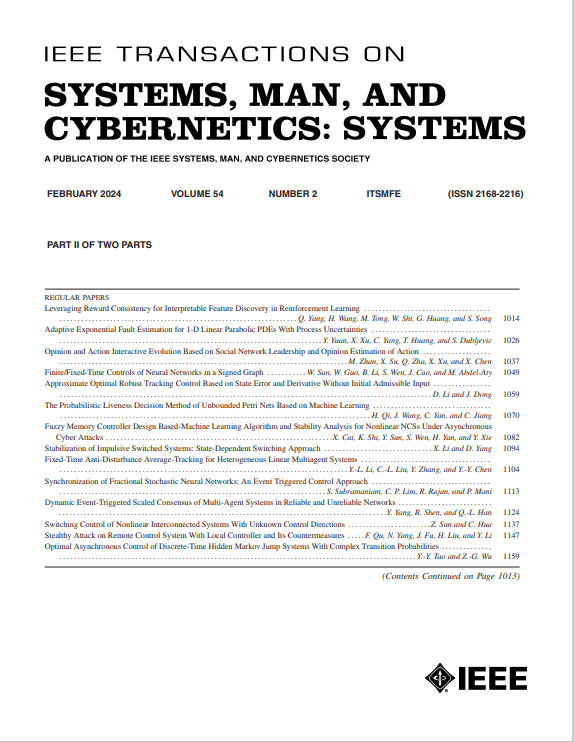Decoupling Design and Fast Kinematics Resolving Method for Cable-Driven Segmented Manipulator
IF 8.7
1区 计算机科学
Q1 AUTOMATION & CONTROL SYSTEMS
IEEE Transactions on Systems Man Cybernetics-Systems
Pub Date : 2025-04-08
DOI:10.1109/TSMC.2025.3554591
引用次数: 0
Abstract
A cable-driven segmented manipulator (CDSM) has considerable potential in narrow space operations because it has a slender and light body with flexible mobility. However, the existing CDSM segment driving mechanisms are coupled to each other. The driving distance of the rear segment cable is superimposed with that of the front segment cable, which renders the cables’ drive distance inconsistent. Moreover, the system kinematics, dynamics, and control become extremely complex. In this article, a novel decoupling driving mechanism is proposed to solve the coupling problem, simplifying the modeling and control of the CDSM. The routing of the driving cable is designed based on the characteristics of the symmetrical offset (i.e., the same magnitude but opposite in direction) of the cable length applicable to joints with one and two degrees of freedom. By modifying the direction of the driving cable in the middle of the proximal segment, the driving cable length of the distal segment is unaffected by the change of the angle of the front segment. Moreover, to increase the drive stroke, a multiturn winding mechanism is designed, reducing the volume and mass of the driving box. Accordingly, an improved forward and backward reaching inverse kinematics is proposed for CDSM based on virtual joints. Compared with the Jacobian pseudo-inverse method, the computational efficiency is improved. Finally, the proposed mechanisms and methods are verified via a CDSM prototype. The results indicate that the proposed manipulator compared with typical manipulators has larger movement range, higher end velocity, and guaranteed accuracy due to the proposed decoupled driving and fast kinematics resolution.索驱动分段机械臂解耦设计及快速运动学求解方法
索驱动分段式机械臂(CDSM)由于具有细长、轻便、灵活移动的特点,在狭窄空间作业中具有相当大的应用潜力。然而,现有的CDSM分段驱动机制是相互耦合的。后段电缆驱动距离与前段电缆驱动距离叠加,导致电缆驱动距离不一致。此外,系统的运动学、动力学和控制变得极其复杂。本文提出了一种新的解耦驱动机构来解决耦合问题,简化了CDSM的建模和控制。驱动电缆的布线是根据电缆长度的对称偏移(即大小相同但方向相反)的特点设计的,适用于具有一个自由度和两个自由度的接头。通过改变近端节段中间驱动缆的方向,远端节段驱动缆长度不受前节段角度变化的影响。此外,为了增加驱动行程,设计了多圈卷绕机构,减小了驱动箱的体积和质量。在此基础上,提出了一种改进的基于虚拟关节的CDSM正向和反向到达逆运动学方法。与雅可比伪逆法相比,提高了计算效率。最后,通过一个CDSM原型验证了所提出的机制和方法。结果表明,由于解耦驱动和快速的运动学分辨率,所提出的机械手与典型的机械手相比,具有更大的运动范围、更高的末端速度和更高的精度保证。
本文章由计算机程序翻译,如有差异,请以英文原文为准。
求助全文
约1分钟内获得全文
求助全文
来源期刊

IEEE Transactions on Systems Man Cybernetics-Systems
AUTOMATION & CONTROL SYSTEMS-COMPUTER SCIENCE, CYBERNETICS
CiteScore
18.50
自引率
11.50%
发文量
812
审稿时长
6 months
期刊介绍:
The IEEE Transactions on Systems, Man, and Cybernetics: Systems encompasses the fields of systems engineering, covering issue formulation, analysis, and modeling throughout the systems engineering lifecycle phases. It addresses decision-making, issue interpretation, systems management, processes, and various methods such as optimization, modeling, and simulation in the development and deployment of large systems.
 求助内容:
求助内容: 应助结果提醒方式:
应助结果提醒方式:


